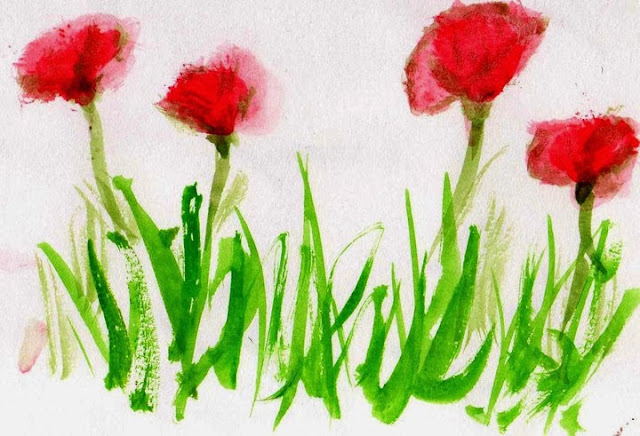Nippon or Nihon
The characters that make up Japan's name mean
"sun-origin", which is why Japan is sometimes referred to as the
"Land of the Rising Sun”
Geography
Japan is an archipelago of 6,852 islands. The four
largest islands are Honshu, Hokkaido, Kyushu, and Shikoku.
The capital of Japan is Tokyo.
The population is over 126 million people.
The Japanese currency is the Yen ¥
Language
There
are five vowels in Japanese language,
a i
u e o
The
sounds are similar to Spanish vowels, so Japanese language is easy to pronounce
for us.
But
writing in Japanese is difficult because you have to learn hiragana, katakana and
kanji.
Hiragana
The hiragana syllabary consists of 48 characters.
These are the four vowels
a
|
i
|
u
|
e
|
o
|
Katakana
This
syllabary is used for transcription of foreign language words into Japanese
The katakana
syllabary consists of 48 characters and these are the five vowels
a
|
i
|
u
|
e
|
o
|
If
you want to write your name in Japanese click on this link
Kanjis
Kanjis
are the Chinese characters that the Japanese use in their language
日本
The above symbols are kanjis.
Primary school children have to learn about 1.500
characters but there are over 50.000 characters.
So learning Japanese language can be
something difficult for us!!
If you like Japanese "manga" this is a very interesting book!
Two Japanese celebrations
If you like Japanese "manga" this is a very interesting book!
Two Japanese celebrations
I
went to Japan in spring 2007 and I could see the beautiful “sakura “ or cherry blossoms.
So
my favourite festival is called “hanami”
Hanami (花見, means
"flower viewing") is the Japanese traditional custom of enjoying the beauty of flowers, especially the cherry blossoms .
People usually meet in parks and sit under the trees to eat the typical
“bento”
Bento is a type of
box or tray with delicious food inside. You can buy it or you can cook it at
home.
Koi nobori
This is Children’s Day in Japan. It is celebrated on 5th May
(5th month).
It used to be the Boy’s day but now it celebrates the happiness of
children. And children usually say thank you to their mothers.
For most people, 5th May is a day to pray for the
health and happiness of their sons.
On this day, the sky is crowded with
fish-shaped kites and flags called koi
nobori. Koi means carp, a kind of fish. They are
usually made of white cloth decorated in red or blue.
When the wind blows the carp kites and flags it looks
as if they are swimming. 
There is special food to be eaten on this day: different kinds of rice cakes.
Sumi e , haikus and ikbanas
Sumi-e es my favourite painting style and it is ink wash painting.
Tras las heladas
se abren flores de nuevo
en la montaña
And then I started to write some haikus for my images. Haikus are really short
poems with just three lines (5-7-5 syllables) and without rhyme
Flor de cerezo
sakura japonesa
Llega el verano
entre unas hierbas crecen
¡Oh, flor de almendro!
Llora pétalos rosas
en el invierno
Pequeña rama
al ver tus flores rosas
tiemblo por dentro
Cae la nieve
y la pequeña barca
se queda inmóvil
This is a copy of a picture of one of my favourite painters HOKUSAI
This picture of the wawes is one of his most popular images
I am also interested in IKEBANA or Japanese flower arrangement.
I met a Japanese teacher in Palma and her workshops were fantastic!
This is one of my first ikebanas
This is not a traditional ikebana but we decided to make a dog with some white carnations... Minie was surprised to see the white dog! (and a bit jealous!)
PHOTOS OF JAPAN 2007
Sakuras in Kyoto
Linis and Ana walking along a canal in Kyoto (Philosopher’s path)
This is a park in Kyoto called “Kitano Tenmangu Shrine”
Four girls wearing kimonos praying at the shrine

Instructions for the prayer: Bend your back, then say the prayer, clap your hands and bend your back again
The school year in Japan starts in spring and this is a picture of some
Japenese students visiting the DAIBUTSU
(the biggest Buddha in Japan)
Aubergine with white miso
This is a typical shinto wedding
And if you want to see some “freakis”, you should go to OMOTESANDO on a Sunday morning.
And if you want to see some “freakis”, you should go to OMOTESANDO on a Sunday morning.
Meditating in a tiny zen garden
This is me with Karin Yamashita, a friend I met in Scotland in an English course.
She’s so peaceful and quiet!
And this is my favourite sand garden.
Ryoanji (Kyoto)
This is a typical meeting point for young people in Shibuya. It’s the statue
of the famous dog Hachiko.
You can read the story if you click on this link
This monk dressed in orange was praying in a street in Tokyo... in front of a Harley
Davidson .
For me this is a symbol of Japan,
tradition and modern life hand by hand.


.jpg)




















































No hay comentarios:
Publicar un comentario